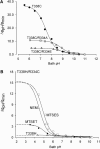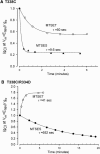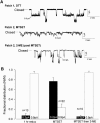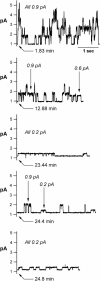CFTR: a cysteine at position 338 in TM6 senses a positive electrostatic potential in the pore
- PMID: 15361410
- PMCID: PMC1304894
- DOI: 10.1529/biophysj.104.050534
CFTR: a cysteine at position 338 in TM6 senses a positive electrostatic potential in the pore
Abstract
We investigated the accessibility to protons and thiol-directed reagents of a cysteine substituted at position 338 in transmembrane segment 6 (TM6) of CFTR to test the hypothesis that T338 resides in the pore. Xenopus oocytes expressing T338C CFTR exhibited pH-dependent changes in gCl and I-V shape that were specific to the substituted cysteine. The apparent pKa of T338C CFTR was more acidic than that expected for a cysteine or similar simple thiols in aqueous solution. The pKa was shifted toward alkaline values when a nearby positive charge (R334) was substituted with neutral or negatively charged residues, consistent with the predicted influence of the positive charge of R334, and perhaps other residues, on the titration of a cysteine at 338. The relative rates of chemical modification of T338C CFTR by MTSET+ and MTSES- were also altered by the charge at 334. These observations support a model for CFTR that places T338 within the anion conduction path. The apparent pKa of a cysteine substituted at 338 and the relative rates of reaction of charged thiol-directed reagents provide a crude measure of a positive electrostatic potential that may be due to R334 and other residues near this position in the pore.
Figures












Similar articles
-
Cystic fibrosis transmembrane conductance regulator: temperature-dependent cysteine reactivity suggests different stable conformers of the conduction pathway.Biochemistry. 2011 Nov 29;50(47):10311-7. doi: 10.1021/bi201176q. Epub 2011 Nov 4. Biochemistry. 2011. PMID: 22014307 Free PMC article.
-
CFTR: Ligand exchange between a permeant anion ([Au(CN)2]-) and an engineered cysteine (T338C) blocks the pore.Biophys J. 2006 Sep 1;91(5):1737-48. doi: 10.1529/biophysj.105.078899. Epub 2006 Jun 9. Biophys J. 2006. PMID: 16766608 Free PMC article.
-
CFTR: covalent and noncovalent modification suggests a role for fixed charges in anion conduction.J Gen Physiol. 2001 Oct;118(4):407-31. doi: 10.1085/jgp.118.4.407. J Gen Physiol. 2001. PMID: 11585852 Free PMC article.
-
Functional roles of nonconserved structural segments in CFTR's NH2-terminal nucleotide binding domain.J Gen Physiol. 2005 Jan;125(1):43-55. doi: 10.1085/jgp.200409174. Epub 2004 Dec 13. J Gen Physiol. 2005. PMID: 15596536 Free PMC article.
-
CFTR: what's it like inside the pore?J Exp Zool A Comp Exp Biol. 2003 Nov 1;300(1):69-75. doi: 10.1002/jez.a.10311. J Exp Zool A Comp Exp Biol. 2003. PMID: 14598388 Review.
Cited by
-
The molecular evolution of function in the CFTR chloride channel.J Gen Physiol. 2021 Dec 6;153(12):e202012625. doi: 10.1085/jgp.202012625. Epub 2021 Oct 14. J Gen Physiol. 2021. PMID: 34647973 Free PMC article.
-
Cysteine scanning of CFTR's first transmembrane segment reveals its plausible roles in gating and permeation.Biophys J. 2013 Feb 19;104(4):786-97. doi: 10.1016/j.bpj.2012.12.048. Biophys J. 2013. PMID: 23442957 Free PMC article.
-
Positioning of extracellular loop 1 affects pore gating of the cystic fibrosis transmembrane conductance regulator.Am J Physiol Lung Cell Mol Physiol. 2016 Mar 1;310(5):L403-14. doi: 10.1152/ajplung.00259.2015. Epub 2015 Dec 18. Am J Physiol Lung Cell Mol Physiol. 2016. PMID: 26684250 Free PMC article.
-
Cystic fibrosis transmembrane conductance regulator: temperature-dependent cysteine reactivity suggests different stable conformers of the conduction pathway.Biochemistry. 2011 Nov 29;50(47):10311-7. doi: 10.1021/bi201176q. Epub 2011 Nov 4. Biochemistry. 2011. PMID: 22014307 Free PMC article.
-
Thermal instability of ΔF508 cystic fibrosis transmembrane conductance regulator (CFTR) channel function: protection by single suppressor mutations and inhibiting channel activity.Biochemistry. 2012 Jun 26;51(25):5113-24. doi: 10.1021/bi300018e. Epub 2012 Jun 15. Biochemistry. 2012. PMID: 22680785 Free PMC article.
References
-
- Akabas, M. H. 1998. Channel-lining residues in the M3 membrane-spanning segment of the cystic fibrosis transmembrane conductance regulator. Biochemistry. 37:12233–12240. - PubMed
-
- Antosiewicz, J., J. A. McCammon, and M. K. Gilson. 1994. Prediction of pH-dependent properties of proteins. J. Mol. Biol. 238:415–436. - PubMed
-
- Antosiewicz, J., J. A. McCammon, and M. K. Gilson. 1996. The determinants of pKas in proteins. Biochemistry. 35:7819–7833. - PubMed
-
- Bashford, D., and K. Gerwert. 1992. Electrostatic calculations of the pKa values of ionizable groups in bacteriorhodopsin. J. Mol. Biol. 224:473–486. - PubMed
-
- Bashford, D., and M. Karplus. 1990. pKas of ionizable groups in proteins: atomic detail from a continuum electrostatic model. Biochemistry. 29:10219–10225. - PubMed
Publication types
MeSH terms
Substances
Grants and funding
LinkOut - more resources
Full Text Sources

